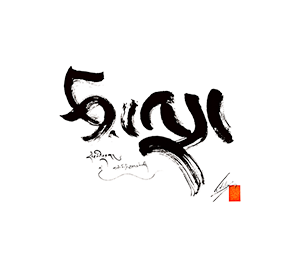Anne Burchardi: On the Sutra Sources for the Uttaratantra and Her Work on the Dharanishvarajasutra
From Buddha-Nature
< Media
Anne Burchardi: On the Sutra Sources for the Uttaratantra and Her Work on the Dharanishvarajasutra - 4 of 7
Video
Video
Previous Video
The Purpose of the Buddha-Nature Teachings by Anne Burchardi: Conversations on Buddha-Nature
Next Video
See The Illustrations of the Nine Examples of the Buddha-Nature from the Tathāgatagarbhasūtra by Sofia Burchardi.
Sources Mentioned
Dhāraṇīśvararājasūtra
Also known as Questions of Dhāraṇīśvararāja Sūtras (Dhāraṇīśvararājasūtra), this lengthy sūtra is stated to be the primary source for the Ratnagotravibhāga since it touches upon all seven vajra topics discussed in the treatise.
Dhāraṇīśvararājasūtra;Śīlendrabodhi;shi len+d+ra bo d+hi;tshul khrims dbang po byang chub; Yeshe De;ཡེ་ཤེས་སྡེ་;ye shes sde;sna nam ye shes sde;zhang ban+de ye shes sde;སྣ་ནམ་ཡེ་ཤེས་སྡེ་;ཞང་བནྡེ་ཡེ་ཤེས་སྡེ་;Dharmarakṣa;'phags pa de bzhin gshegs pa'i snying rje chen po nges par bstan pa zhes bya ba theg pa chen po'i mdo;འཕགས་པ་དེ་བཞིན་གཤེགས་པའི་སྙིང་རྗེ་ཆེན་པོ་ངེས་པར་བསྟན་པ་ཞེས་བྱ་བ་ཐེག་པ་ཆེན་པོའི་མདོ།;tathāgatamahākaruṇānirdeśasūtra;大哀經
Maitreya, Asaṅga: Ratnagotravibhāga Mahāyānottaratantraśāstra
The Ratnagotravibhāga, commonly known as the Uttaratantra, or Gyu Lama in Tibetan, is one of the main Indian scriptural sources for buddha-nature theory. It was likely composed during the fifth century, by whom we do not know. Comprised of verses interspersed with prose commentary, it systematizes the buddha-nature teachings that were circulating in multiple sūtras such as the Tathāgatagarbhasūtra, the Mahāparinirvāṇasūtra, and the Śrīmaladevisūtra. The Tibetan tradition attributes the verses to the Bodhisattva Maitreya and the commentary to Asaṅga, and treats the two as separate texts, although this division is not attested to in surviving Indian versions. The Chinese tradition attributes the text to *Sāramati (娑囉末底), but the translation itself does not include the name of the author, and the matter remains unsettled. It was translated into Chinese in the early sixth century by Ratnamati and first translated into Tibetan by Atiśa, although this text is not known to survive. Ngok Loden Sherab translated it a second time based on teachings from the Kashmiri Pandita Sajjana, and theirs remains the standard translation. It has been translated into English several times, and recently into French. See the Ratnagotravibhāgavyākhyā, read more about the Ratnagotravibhāga, or take a look at the most complete English translation in When the Clouds Part by Karl Brunnholzl.
Ratnagotravibhāga Mahāyānottaratantraśāstra;byams chos sde lnga;Uttaratantra;Maitreya;བྱམས་པ་;byams pa;'phags pa byams pa;byams pa'i mgon po;mgon po byams pa;ma pham pa;འཕགས་པ་བྱམས་པ་;བྱམས་པའི་མགོན་པོ་;མགོན་པོ་བྱམས་པ་;མ་ཕམ་པ་;Ajita; Asaṅga;ཐོགས་མེད་;thogs med;slob dpon thogs med;སློབ་དཔོན་ཐོགས་མེད་;Āryāsaṅga;Sajjana;ས་ཛ་ན་;sa dza na;paN+Di ta sa dza na;sa dzdza na;པཎྜི་ཏ་ས་ཛ་ན་;ས་ཛཛ་ན་;Ngok Lotsāwa Loden Sherab;རྔོག་བློ་ལྡན་ཤེས་རབ་;rngog blo ldan shes rab;rngog lo tsA ba;lo chen blo ldan shes rab;blo ldan shes rab;རྔོག་ལོ་ཙཱ་བ་;ལོ་ཆེན་བློ་ལྡན་ཤེས་རབ་;Ngok Lotsāwa;Ngok Loden Sherab;Lochen Loden Sherab;Loden Sherab;Ratnamati;Rin chen blo gros;རིན་ཆེན་བློ་གྲོས;theg pa chen po rgyud bla ma'i bstan bcos;ཐེག་པ་ཆེན་པོ་རྒྱུད་བླ་མའི་བསྟན་བཅོས།;Ratnagotravibhāga Mahāyānottaratantraśāstra;究竟一乘寶性論;रत्नगोत्रविभाग महायानोत्तरतन्त्रशास्त्र;ཐེག་པ་ཆེན་པོ་རྒྱུད་བླ་མའི་བསྟན་བཅོས།
Tathāgatagarbhasūtra
The Tathāgatagarbhasūtra (TGS) is a relatively short text that represents the starting point of a number of works in Indian Mahāyāna Buddhism centering around the idea that all living beings have the buddha-nature. The genesis of the term tathāgatagarbha (in Tibetan de bzhin gshegs pa'i snying po, in Chinese rulai zang 如來藏, the key term of this strand of Buddhism and the title of the sūtra), can be observed in the textual history of the TGS. (Zimmermann, A Buddha Within: The Tathāgatagarbhasūtra, p. 7)
Tathāgatagarbhasūtra;Amoghavajra; Buddhabhadra;Śākyaprabha;ཤཱཀྱ་འོད་;shAkya 'Od;Yeshe De;ཡེ་ཤེས་སྡེ་;ye shes sde;sna nam ye shes sde;zhang ban+de ye shes sde;སྣ་ནམ་ཡེ་ཤེས་སྡེ་;ཞང་བནྡེ་ཡེ་ཤེས་སྡེ་;'phags pa de bzhin gshegs pa'i snying po zhes bya ba theg pa chen po'i mdo;འཕགས་པ་དེ་བཞིན་གཤེགས་པའི་སྙིང་པོ་ཞེས་བྱ་བ་ཐེག་པ་ཆེན་པོའི་མདོ།;Tathāgatagarbhasūtra;大方廣如來藏經;तथागतगर्भसूत्र
Buddhāvataṃsakasūtra
One of the longest works in the entire Buddhist canon, the Buddhāvataṃsakasūtra is widely considered to be a compilation of independent scriptures, which was expanded upon over the course of time. It was extremely influential in East Asia, where it was preserved in an eighty-scroll recension. The Tibetan translation of this work fills four volumes in the Derge Kangyur. Though only two sections—namely, the Gaṇḍavyūhasūtra and the Daśabhūmikasūtra—have survived in Sanskrit, both of which have also circulated as independent works.
Buddhāvataṃsakasūtra;Vairotsana;བཻ་རོ་ཙ་ན་;bai ro tsa na;lo chen bai ro tsa na;pa gor bai ro tsa na;ལོ་ཆེན་བཻ་རོ་ཙ་ན་;པ་གོར་བཻ་རོ་ཙ་ན་; Buddhabhadra;Jinamitra;ཇིནམིཏྲ;slob dpon dzi na mi tra;Surendrabodhi;lha dbang byang chub;Yeshe De;ཡེ་ཤེས་སྡེ་;ye shes sde;sna nam ye shes sde;zhang ban+de ye shes sde;སྣ་ནམ་ཡེ་ཤེས་སྡེ་;ཞང་བནྡེ་ཡེ་ཤེས་སྡེ་;Śikṣānanda;sangs rgyas phal po che zhes bya ba shin tu rgyas pa chen po'i mdo;སངས་རྒྱས་ཕལ་པོ་ཆེ་ཞེས་བྱ་བ་ཤིན་ཏུ་རྒྱས་པ་ཆེན་པོའི་མདོ།;Buddhāvataṃsakamahāvaipūlyasūtra;大方廣佛華嚴經;बुद्धावतंसकसूत्र
Secondary Publications Mentioned
About the video
| Featuring | Anne Burchardi, Karma Phuntsho |
|---|---|
| Creator | Tsadra Foundation |
| Director | Perman, M. |
| Producer | Tsadra Foundation |
| Event | The Purpose of the Buddha-Nature Teachings by Anne Burchardi: Conversations on Buddha-Nature (18 December 2021, Denmark and Bhutan) |
| Related Website | Buddha-Nature |
| Creation Date | 18 December 2021 |
| Citation | Burchardi, Anne. "On the Sutra Sources for the Uttaratantra and Her Work on the Dharanishvarajasutra." Conversations on Buddha-Nature with Lopen Dr. Karma Phuntsho. Produced by the Tsadra Foundation Research Department, December 18, 2021. Video, 8:43. https://www.youtube.com/watch?v=htbHopiQeYg. |
